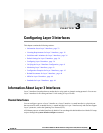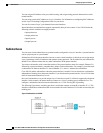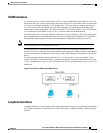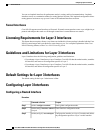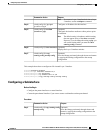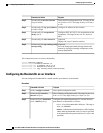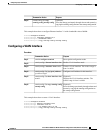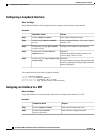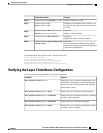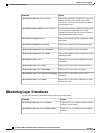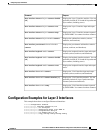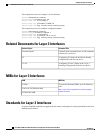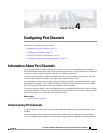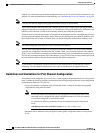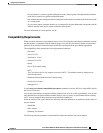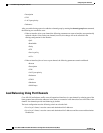
PurposeCommand or Action
Adds this interface to a VRF.
switch(conifg-if)#vrf member vrf-name
Step 3
Configures an IP address for this interface. You
must do this step after you assign this interface
to a VRF.
switch(config-if)# [ip |
ipv6]ip-address/length
Step 4
(Optional)
Displays VRF information.
switch(config-if)# show vrf [vrf-name]
interface interface-type number
Step 5
(Optional)
Displays the Layer 3 interface statistics.
switch(config-if)# show interfaces
Step 6
(Optional)
Saves the change persistently through reboots
and restarts by copying the running configuration
to the startup configuration.
switch(config-if)# copy running-config
startup-config
Step 7
This example shows how to add a Layer 3 interface to the VRF:
switch# configure terminal
switch(config)# interface loopback 0
switch(config-if)# vrf member RemoteOfficeVRF
switch(config-if)# ip address 209.0.2.1/16
switch(config-if)# copy running-config startup-config
Verifying the Layer 3 Interfaces Configuration
Use one of the following commands to verify the configuration:
PurposeCommand
Displays the Layer 3 interface configuration, status,
and counters (including the 5-minute exponentially
decayed moving average of inbound and outbound
packet and byte rates).
show interface ethernet slot/port
Displays the Layer 3 interface operational status.
show interface ethernet slot/port brief
Displays the Layer 3 interface capabilities, including
port type, speed, and duplex.
show interface ethernet slot/port capabilities
Displays the Layer 3 interface description.
show interface ethernet slot/port description
Displays the Layer 3 interface administrative status,
port mode, speed, and duplex.
show interface ethernet slot/port status
Cisco Nexus 5000 Series NX-OS Interfaces Configuration Guide, Release 5.2(1)N1(1)
78-26881-OL 41
Configuring Layer 3 Interfaces
Verifying the Layer 3 Interfaces Configuration



